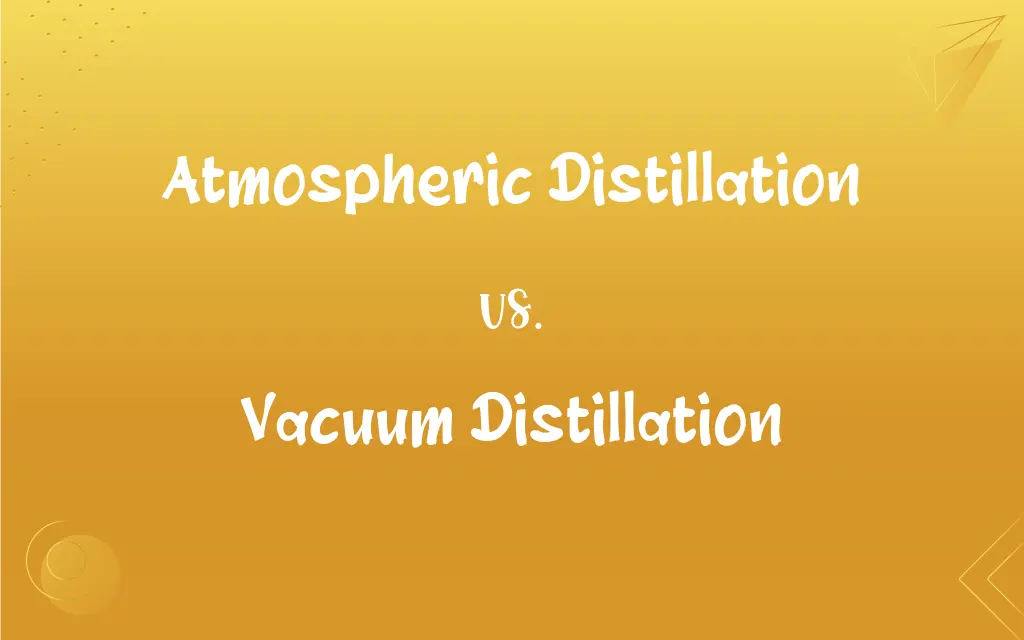Atmospheric Distillation vs. Vacuum Distillation: What's the Difference?
Edited by Aimie Carlson || By Janet White || Published on March 3, 2024
Atmospheric distillation is a process of separating components of a liquid mixture under atmospheric pressure, while vacuum distillation is carried out under reduced pressure, allowing for distillation at lower temperatures.

Key Differences
Atmospheric distillation operates at normal atmospheric pressure and is typically used for mixtures with components that have relatively low boiling points. Vacuum distillation is used for substances with higher boiling points, as the reduced pressure lowers the boiling temperatures, preventing thermal decomposition.
In atmospheric distillation, the separation of components depends on their different boiling points at normal pressure. Vacuum distillation allows for the distillation of heat-sensitive materials or those with very high boiling points by reducing the pressure, which in turn lowers the boiling points of the components.
Atmospheric distillation is commonly used in the refining of crude oil into various fractions like gasoline and kerosene. Vacuum distillation is often employed in processing heavy residues from atmospheric distillation, producing lubricating oils and waxes.
Energy consumption in atmospheric distillation is generally higher due to the need for higher temperatures. Vacuum distillation, by reducing the boiling point, can be more energy-efficient, especially for high-boiling substances.
Atmospheric distillation is simpler in terms of equipment and operation compared to vacuum distillation, which requires additional equipment like vacuum pumps and more careful operational control to maintain the reduced pressure.
ADVERTISEMENT
Comparison Chart
Pressure Environment
Operates at atmospheric pressure
Operates under reduced pressure
Boiling Point Requirements
Suitable for lower boiling points
Lowers boiling points of substances
Common Usage
Refining crude oil into lighter fractions
Processing heavy residues, high-boiling substances
Energy Consumption
Generally higher due to higher temperatures
More energy-efficient for high-boiling materials
Equipment Complexity
Simpler equipment setup
Requires vacuum pumps, more complex setup
ADVERTISEMENT
Atmospheric Distillation and Vacuum Distillation Definitions
Atmospheric Distillation
A process for separating components of a mixture under normal pressure.
Kerosene is obtained through atmospheric distillation of crude oil.
Vacuum Distillation
Used for separating components that would decompose at high temperatures.
Vacuum distillation is applied in the recycling of used motor oils.
Atmospheric Distillation
Separation of liquids at normal atmospheric pressure.
Atmospheric distillation is used in crude oil refining.
Vacuum Distillation
Distillation technique for preventing thermal decomposition.
Vacuum distillation helps in processing heavy fractions of crude oil.
Atmospheric Distillation
A method to separate liquid mixtures based on boiling points at 1 atm pressure.
Distilling ethanol from a fermentation broth is done via atmospheric distillation.
Vacuum Distillation
A method used for substances with high boiling points.
Lubricating oils are often produced using vacuum distillation.
Atmospheric Distillation
The basic form of distillation conducted at atmospheric conditions.
Atmospheric distillation is a common technique in chemical laboratories.
Vacuum Distillation
A process to distill heat-sensitive materials at lower temperatures.
Pharmaceutical compounds are frequently purified by vacuum distillation.
Atmospheric Distillation
Distillation process for substances with low to medium boiling points.
The production of gasoline involves atmospheric distillation.
Vacuum Distillation
Distillation under reduced pressure to lower boiling points.
Vacuum distillation is essential for purifying temperature-sensitive compounds.
FAQs
What is the main advantage of vacuum distillation?
It allows the distillation of high-boiling substances at lower temperatures, preventing decomposition.
Can atmospheric distillation separate all components of crude oil?
No, it's mainly for lighter fractions; heavier fractions require vacuum distillation.
Is vacuum distillation more energy-efficient?
Yes, especially for substances with high boiling points, as it requires lower temperatures.
What products are commonly obtained through atmospheric distillation of crude oil?
Gasoline, kerosene, and diesel are typical products.
What industries use vacuum distillation?
It's used in petrochemical, pharmaceutical, and waste oil recycling industries.
Why is atmospheric distillation used in oil refineries?
It's used to separate crude oil into lighter fractions like gasoline under normal pressure.
What is the role of a vacuum pump in vacuum distillation?
It reduces the pressure within the distillation apparatus.
Why is reduced pressure used in vacuum distillation?
To lower the boiling points of the components, making the process more efficient and gentle.
Is atmospheric distillation suitable for temperature-sensitive materials?
No, for heat-sensitive materials, vacuum distillation is more appropriate.
Is vacuum distillation used in environmental applications?
Yes, it's used in waste management and recycling processes.
Are there any limitations to atmospheric distillation?
It's limited by the boiling point range of the substances that can be effectively separated.
Can vacuum distillation process larger molecules?
Yes, it's particularly useful for larger, more complex molecules.
What safety measures are important in atmospheric distillation?
Proper temperature control and pressure monitoring are essential.
Why is temperature control critical in vacuum distillation?
To ensure efficient separation without damaging heat-sensitive components.
Does atmospheric distillation require complex equipment?
It requires relatively simpler equipment compared to vacuum distillation.
Is atmospheric distillation faster than vacuum distillation?
Not necessarily; the speed depends on the mixture and desired level of separation.
Can vacuum distillation be used in food processing?
Yes, it's used for delicate food products and flavors.
Can atmospheric distillation separate all mixtures effectively?
Its effectiveness depends on the boiling point differences of the mixture's components.
How does atmospheric pressure influence the distillation process?
It determines the boiling points of the substances being distilled.
About Author
Written by
Janet WhiteJanet White has been an esteemed writer and blogger for Difference Wiki. Holding a Master's degree in Science and Medical Journalism from the prestigious Boston University, she has consistently demonstrated her expertise and passion for her field. When she's not immersed in her work, Janet relishes her time exercising, delving into a good book, and cherishing moments with friends and family.
Edited by
Aimie CarlsonAimie Carlson, holding a master's degree in English literature, is a fervent English language enthusiast. She lends her writing talents to Difference Wiki, a prominent website that specializes in comparisons, offering readers insightful analyses that both captivate and inform.































































